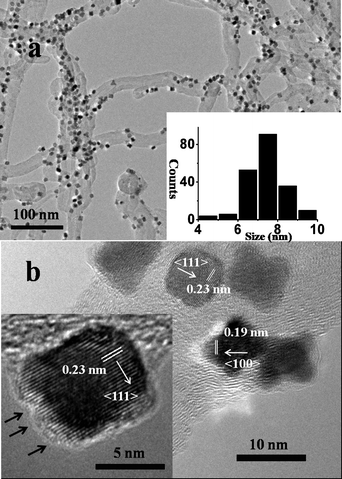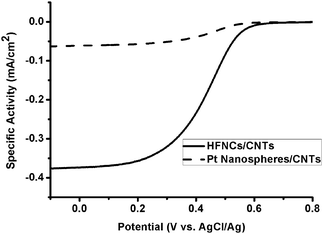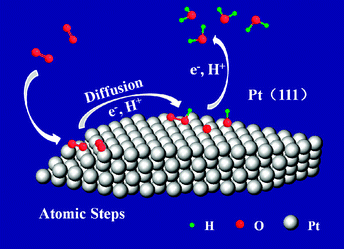Rational preparation of faceted platinum nanocrystals supported on carbon nanotubes with remarkably enhanced catalytic performance†
Ziyin
Lin
,
Haibin
Chu
,
Yihong
Shen
,
Li
Wei
,
Haichao
Liu
and
Yan
Li
*
Beijing National Laboratory for Molecular Sciences, State Key Laboratory of Rare Earth Materials Chemistry and Application, Key Laboratory for the Physics and Chemistry of Nanodevices, College of Chemistry and Molecular Engineering, Peking University, Beijing 100871, China. E-mail: yanli@pku.edu.cn; Fax: (+86)10-6275-6773
First published on 15th October 2009
Abstract
Faceted platinum nanocrystals supported on carbon nanotubes were prepared using NO2− as a crucial shape-controlling agent. The composites exhibit high electrochemical catalytic activity for oxygen reduction facilitated by the cooperation between the Pt{111} facets and atomic steps, and extremely high selectivity for the oxidation of glycerol to glyceraldehyde.
Properties of nanomaterials are highly dependent on their structures and morphologies. For example, the significance of controlling the morphologies of Pt nanocrystals for catalytic applications has been well presented in the synthesis of Pt trahexahedral nanocrystals,1 nanocubes,2 nanostars3 and multioctahedrals.4 These materials exhibit improved catalytic performances (i.e. activity and/or selectivity) for certain reactions, sensitively depending on their exposed Pt facets. Considering that such phenomena of structure-sensitivity in catalytic performance are prevalently found in many multi-step reactions, in which each step may have its own “favorite” facet, it is reasonable to expect that using the cooperation between different facets towards different steps can realize the remarkably higher performance of catalysts in a multi-step reaction. We thus attempted to prepare Pt nanocrystals selectively exposing two or more different types of facets and investigate their catalytic functions. Oxygen reduction and glycerol oxidation were selected as typical reactions for this study. It is anticipated that the structure design and controlled synthesis of Pt nanocrystals would lead to superior catalytic properties.
Pt nanocrystals as catalysts are usually loaded on carbon supports, which prevent them from aggregation, increase the active surface area, and provide electronically conductive substrates. Recently, carbon nanotubes (CNTs) have drawn great attention in acting as catalyst supports.5–7 Compared with traditional carbon black, CNTs have sp2 hybridized surface carbon atoms and higher conductivity.8 CNTs do not have micropores, into which small metal nanocrystals may sink and become inaccessible. Moreover, CNTs are inert in most situations, while carbon black is relatively more active in strong oxidation environments.9 Therefore we chose CNTs as the supports.
A variety of methods have been developed to prepare nanocrystal/CNT composites.10–13 However, so far there are very few reports about the shape-controlled synthesis of nanocrystals supported on CNTs. Nevertheless, the solution chemistry routes, which are more flexible and obtain more tunable reaction parameters, offer us possible strategies to realize the shape- and even facet-controlled preparation of nanocrystals on CNTs. Here, we report a facile method for synthesizing highly faceted Pt nanocrystals (HFNCs) which expose Pt{111} facets and have considerable amount of atomic steps supported on CNTs. Ethylene glycol was used as both the solvent and the reductant, and PVP as the protecting agent.14 Notably, NaNO2 was introduced for the first time into the solution as a shape-controlling agent, which increased the surface roughness and produced the atomic steps. The presence of NO2−, PVP and CNTs ensured the uniformity of the obtained HFNCs.
Fig. 1 shows the TEM and HRTEM images for the as-synthesized HFNCs supported on CNTs (HFNCs/CNTs) at an NO2−/Pt molar ratio of 6. It can be seen that HFNCs are uniform and well dispersed on the outside walls of CNTs. The surfaces of the nanoparticles have concave and protruding corners. The average size of the particles is 7.4 nm ± 1.0 nm (inset in Fig. 1(a)). The particle size increases slightly with increased NO2− concentration (Fig. S1 in ESI†). The HRTEM image (inset in Fig. 1(b)) shows that the Pt lattice fringes parallel to the outer surface of the nanocrystals have an interfringe distance of 0.23 nm, indicating that the crystals are mainly enclosed by Pt{111} facets. XRD characterization of the products (Fig. S2, ESI†) shows a well-defined pattern of Pt nanoparticles. These nanocrystals have rough surfaces, with a large number of atomic steps as pointed out by the arrows in Fig. 1(b). We have checked the HRTEM images of ∼40 HFNCs, they all show similar morphology.
 | ||
| Fig. 1 TEM (a) and HRTEM (b) images of Pt nanocrystals attached on CNTs when the ratio of NO2−/Pt is 6. The inset in (a) is the diameter distribution histogram, and the inset in (b) shows the atomic steps on the Pt(111) surface indicated by the black arrows. | ||
Several control experiments were performed to verify the formation mechanism of HFNCs (see Fig. S4 and detailed discussion in ESI†). When no NO2− was added or NO2− was substituted by Cl− or ClO4−, only irregular nanoparticles were formed. It was found that NO2− plays a crucial role in the formation of HFNCs. NO2− can act as both the ligand to coordinate with Pt(II) and Pt(IV) species and as the oxidant for the transformation from Pt(0) to Pt(II) and Pt(IV). Therefore, with the aid of dissolved oxygen, it can etch the nanoparticles and introduce atomic steps to the surfaces of nanoparticles. Meanwhile, the presence of NO2− also remarkably slows down the formation of Pt(0). The low supply of Pt(0) atoms in the nucleation and growth process of Pt nanocrystals benefits the formation of thermodynamically stable products and eventually leads to the disappearance of facets with higher surface energy leaving the {111} facets which have the lowest surface energy.14,15 The presence of PVP in the reaction solution also benefits the formation of Pt nanocrystals enclosed by {111} facets.14,15 In addition, NO2− and PVP both contribute to the narrow size distribution of the produced nanoparticles. We also found that the presence of CNTs in the reaction solution tends to lead to uniform Pt nanoparticles (Fig. S5, ESI†) because CNTs can provide more heterogeneous nucleation centers, which is beneficial to quick and uniform nucleation and growth of nanocrystals.14,16 From the above discussion, we know that NO2− takes the key role and PVP and CNTs the assistant roles in tuning the synthesis pathways, and therefore the formation of HFNCs.
Platinum has been widely used as an important catalyst in various fuel cells.7,17 Therefore we evaluated the electrocatalytic activity of HFNCs/CNTs toward the oxygen reduction reaction, which normally takes places at the cathode of a fuel cell. The samples show well defined current–potential curves for oxygen reduction (Fig. S7, ESI†) in HClO4 media. The starting potential is 0.56 V and the half-wave potential is 0.43 V. The specific catalytic activity of each sample was calculated by dividing the raw electrocatalytic current over the Pt surface area, which is obtained by the collected charge in the hydrogen underpotential desorption region (Fig. S8, ESI†). The specific activity of each sample is presented in Fig. 2, in which the activity of HFNCs/CNTs at 0.43 V is 0.195 mA cm−2, five times higher than that of the Pt nanosphere/CNTs reference (0.0325 mA cm−2) used for comparison (Fig. S6 in ESI†).
 | ||
| Fig. 2 Specific activity curves of HFNCs/CNTs and Pt nanospheres/CNTs with a scanning rate of 5 mV s−1 in O2-saturated HClO4 solution (0.1 M), the rotation speed is 1600 rpm. | ||
What is the reason that the HFNCs show tremendously increased activity to oxygen reduction reaction? The oxygen reduction reaction has been intensively studied and the mechanism is relatively clear to us. It is a multi-step reaction and its reaction rate is mainly determined by two steps including the adsorption of oxygen and its subsequent reduction.18 Pt nanospheres are enclosed by mixed {111} and {100} facets.16 In non-absorbing electrolyte HClO4, Pt(111) has higher catalytic activity than Pt(100) for the reduction of oxygen.18 While the catalytic performance of Pt(111) is generally limited by its poor ability in oxygen adsorption our HFNCs present a large amount of atom steps interlaced with Pt{111} facets at the particle surfaces. The atoms at the steps are low coordinated and therefore show enhanced adsorption ability for oxygen species.19 The adsorbed oxygen species can then easily diffuse to the adjacent Pt(111) facets and be reduced catalytically.18,20 Thus, the higher catalytic activity of HFNCs toward oxygen reduction reaction than the ordinary Pt nanospheres is originated from the cooperation between the exposed Pt{111} facets and the atomic steps on the HFNC surfaces, as depicted in Scheme 1. The electrocatalytic oxygen reduction is shown to be a successful example for our idea of using the cooperation between different facets aiming at different steps of a multi-step reaction to realize the higher performance of catalysts.
 | ||
| Scheme 1 The atomic steps and Pt(111) facets cooperate in catalyzing oxygen reduction reaction. | ||
Besides electrocatalysis towards the oxygen reduction reaction, we also studied the catalytic performance of HFNCs/CNTs to other reactions, for example the selective oxidation of glycerol. Glycerol is an important compound derived from bio-sustainable sources. The catalytic oxidation of glycerol is of great interest because it can be transformed into various value-added chemicals which can find wide applications in fuel, pharmaceutical, automotive and chemical industries.21 Platinum has been used as a catalyst for the selective oxidation of glycerol.21–23 It is normally supported on active carbon and shows a selectivity to primary hydroxyl groups.21–23 We performed the catalytic oxidation of glycerol using HFNCs/CNTs at 60 °C. The TOF and composition of the products are shown in Table S1 in ESI.† The amounts of key products are shown in Table 1 in comparison with the reported data using normal platinum nanoparticles supported on active carbon (Pt/C) as catalyst23 under a similar reaction condition. It can be seen that HFNCs/CNTs exhibit a very high selectivity towards the oxidation of primary hydroxyl groups (∼80%). More importantly, HFNCs/CNTs show a remarkably higher selectivity to glyceraldehyde rather than glyceric acid (79.2% vs. 0.5%) in comparison with the normal Pt/C catalysts (2.1% vs. 47.4%) under similar reaction conditions.23 It is widely accepted that glyceric acid is a thermodynamically more stable product than glyceraldehyde and normally the oxidation will go eventually to the final product of glyceric acid.21–23 However, HFNCs/CNTs catalyst can induce the oxidization to effectively cease at the stage of glyceraldehyde. Moreover, much fewer by-products, especially those with broken C–C bonds such as glycolic acid (3.5% vs. 13.6%), are formed on HFNCs/CNTs than on Pt/C.23 Such superior behaviour of the HFNCs may be contributed to their specific structures on CNTs although the underlying mechanism is unclear at this stage.
In summary, we have developed a strategy to prepare highly faceted Pt nanocrystals on CNTs which show outstanding catalytic performances. Relying on the oxidation and coordination effect, NO2− serves as the crucial shape-controlling agent. The addition of CNTs helps to obtain uniform Pt nanoparticles. The obtained Pt nanoparticles selectively expose {111} facets and create a considerable amount of atomic steps. Due to the cooperative effect between their {111} facets and atomic steps, these Pt particles show remarkably higher electrocatalytic activity toward the oxygen reduction reaction. They also exhibit an impressively high selectivity for the oxidation of glycerol to glyceraldehyde. These results demonstrate that the rational design and controlled preparation of nanomaterials with specific structures can bring about extraordinary properties.
We acknowledge the funding from the Ministry of Science and Technology of China (Projects 2006CB932403, 2006CB932701, and 2007CB936202) and the National Natural Science Foundation of China (Project 9050772002).
Notes and references
- N. Tian, Z. Zhou, S. Sun, Y. Ding and Z. L. Wang, Science, 2007, 316, 732–735 CrossRef CAS.
- C. Wang, H. Daimon, Y. M. Lee, J. M. Kim and S. Sun, J. Am. Chem. Soc., 2007, 129, 6974–6975 CrossRef CAS.
- M. A. Mahmoud, C. E. Tabor, M. A. El-Sayed, Y. Ding and Z. L. Wang, J. Am. Chem. Soc., 2008, 130, 4590–4591 CrossRef CAS.
- B. K. Lim, X. Lu, M. Jiang, P. H. C. Camargo, E. C. Cho, E. P. Lee and Y. Xia, Nano Lett., 2008, 8, 4043–4047 CrossRef CAS.
- (a) X. Pan, Z. Fan, W. Chen, Y. Ding, H. Luo and X. Bao, Nat. Mater., 2007, 6, 507–511 CrossRef CAS; (b) W. Chen, Z. Fan, X. Pan and X. Bao, J. Am. Chem. Soc., 2008, 130, 9414–9419 CrossRef CAS.
- J. Kang, S. Zhang, Q. Zhang and Y. Wang, Angew. Chem., Int. Ed., 2009, 48, 2565–2568 CrossRef CAS.
- (a) W. Li, C. Liang, W. Zhou, J. Qiu, Z. Zhou, G. Sun and Q. Xin, J. Phys. Chem. B, 2003, 107, 6292–6299 CrossRef CAS; (b) S. Liao, K.-A. Holmes, H. Tsaprailis and V. I. Birss, J. Am. Chem. Soc., 2006, 128, 3504–3505 CrossRef CAS.
- R. Saito, M. S. Dresselhaus and G. Dresselhaus, Physical Properties of Carbon Nanotubes, World Scientific Publishing, Singapore, 1998 Search PubMed.
- K. C. Lee, J. Zhang, H. Wang and D. P. Wilkinson, J. Appl. Electrochem., 2006, 36, 507–522 CrossRef CAS.
- (a) H. C. Choi, M. Shim, S. Bangsaruntip and H. J. Dai, J. Am. Chem. Soc., 2002, 124, 9058–9059 CrossRef CAS; (b) D. S. Kim, T. Lee and K. E. Geckeler, Angew. Chem., Int. Ed., 2006, 45, 104–107 CrossRef CAS.
- (a) H. Chu, Z. Jin, Y. Zhang, W. Zhou, L. Ding and Y. Li, J. Phys. Chem. C, 2008, 112, 13437–13441 CrossRef CAS; (b) C. Li, Z. Jin, H. Chu and Y. Li, J. Nanosci. Nanotechnol., 2008, 8, 4441–4446 CrossRef CAS; (c) C. Li, N. Sun, J. Ni, J. Wang, H. Chu, H. Zhou, M. Li and Y. Li, J. Solid State Chem., 2008, 181, 2620–2625 CrossRef CAS.
- L. Qu and L. Dai, J. Am. Chem. Soc., 2005, 127, 10806–1087 CrossRef CAS.
- (a) B. M. Quinn, C. Dekker and S. G. Lemay, J. Am. Chem. Soc., 2005, 127, 6146–6147 CrossRef CAS; (b) T. M. Day, P. R. Unwin, N. R. Wilson and J. V. Macpherson, J. Am. Chem. Soc., 2005, 127, 10639–10647 CrossRef CAS.
- A. R. Tao, S. Habas and P. Yang, Small, 2008, 4, 310–325 CrossRef CAS.
- B. Lim, J. Wang, P. H. C. Camargo, C. M. Cobley, M. J. Kim and Y. Xia, Angew. Chem., Int. Ed., 2009, 48, 6304–6308 CrossRef CAS.
- Y. Xia, Y. Xiong, B. K. Lim and S. E. Skrabalak, Angew. Chem., Int. Ed., 2008, 47, 8646–46 CrossRef CAS.
- (a) S. H. Joo, S. J. Choi, I. Oh, J. Kwak, Z. Liu, O. Terasaki and R. Ryoo, Nature, 2001, 412, 169–172 CrossRef CAS; (b) S. Wasmus and A. Kuver, J. Electroanal. Chem., 1999, 461, 14–31 CrossRef CAS; (c) C. Lamy, A. Lima, V. LeRhun, F. Delime, C. Coutanceau and J. M. Leger, J. Power Sources, 2002, 105, 283–296 CrossRef CAS; (d) H. A. Gasteiger, S. S. Kocha, B. Sompalli and F. T. Wagner, Appl. Catal., B, 2005, 56, 9–35 CrossRef CAS.
- A. Panchenko, M. T. M. Koper, T. E. Shubina, S. J. Mitchell and E. Roduner, J. Electrochem. Soc., 2004, 151, A2016–A2027 CrossRef CAS.
- K. J. J. Mayrhofer, D. Strmcnik, B. B. Blizanac, V. Stamenkovic, M. Arenz and N. M. Markovic, Electrochim. Acta, 2008, 53, 3181–3188 CrossRef CAS.
- V. Komanicky, H. Iddir, K. C. Chang, A. Menzel, G. Karapetrov, D. Hennessy, P. Zapol and H. You, J. Am. Chem. Soc., 2009, 131, 5732–5733 CrossRef CAS.
- M. Pagliaro, R. Ciriminna, H. Kimura, M. Rossi and C. D. Pina, Angew. Chem., Int. Ed., 2007, 46, 4434–4440 CrossRef CAS.
- (a) R. Garcia, M. Besson and P. Gallezot, Appl. Catal., A, 1995, 127, 165–176 CrossRef CAS; (b) S. Carrettin, P. McMorn, P. Johnston, K. Griffin, C. J. Kiely and G. J. Hutchings, Phys. Chem. Chem. Phys., 2003, 5, 1329–1336 RSC; (c) C. L. Bianchi, P. Canton, N. Dimitratos, F. Porta and L. Prati, Catal. Today, 2005, 102–103, 203–212 CrossRef CAS; (d) N. Dimitratos, C. Messi, F. Porta, L. Prati and A. Villa, J. Mol. Catal. A: Chem., 2006, 256, 21–28 CrossRef CAS.
- D. Liang, J. Gao, J. Wang, P. Chen, Z. Hou and X. Zheng, Catal. Commun., 2009, 10, 1586–1590 CrossRef CAS.
Footnote |
| † Electronic supplementary information (ESI) available: Experimental section and supplementary data. See DOI: 10.1039/b917235a |
| This journal is © The Royal Society of Chemistry 2009 |
